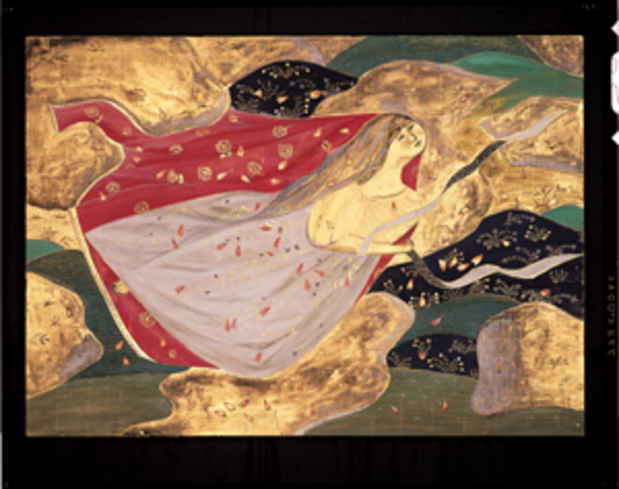Yoko Semoto "Paintings in Tempera on Gold Backgrounds"
Ippodo Gallery

This event has ended.
Born in 1930, Yoko SEMOTO is now eighty years old and continues to work actively, producing tempera paintings on lavish, gold-leaf backgrounds. The daughter of a strict stockbroker and frugal mother, she enjoyed a rich education, studying oil painting after the Second World War, then moving to Paris on her own in 1962. Her original intention had been to study the work of the Impressionists, but she became fascinated with the medieval/early-renaissance paintings she discovered in the Louvre Museum and began traveling regularly to Italy to study the tempera paintings there.
After returning to Japan, she visited numerous temples to study Buddhist statues. In so doing her unique eye discerned a fundamental similarity that exists between Buddhist and medieval/early-renaissance art, and decided to devote herself to the recreation of the ideal of the sanctification of truth, virtue and beauty or the simple bliss to be found in daily life, through modern tempera paintings. It proved extremely difficult to study tempera painting in Japan at that time. Her only instruction came from ‘Il libro dell'arte’ (The Craftsman's Handbook), a book written by Cennino Cennini in around 1400, which describes the techniques used in the Florentine studios at that time. However, through perseverance she gradually succeeded in mastering the art of painting in egg tempera on a gold background.
SEMOTO goes to great lengths to obtain the materials she uses in her work. In an effort to recreate the transparent tones of the numerous medieval tempera paintings she saw while she was in Europe, she carried out repeated experiments using traditional Japanese pigments and hide glue and in addition, wherever she travels, she gathers samples of rocks that she uses to create her own, unique pigments. In particular the blue she uses is obtained from natural lapis lazuli rock while the sepia is produced from squid ink. She also uses only the very best quality verdigris, natural rose madder and Japanese gold leaf, and this is probably because she believes that the changes that take place in the colors over the passage of years represent an almost sacred process of regeneration and resurrection within the world of nature.
SEMOTO’s work expresses the simple joy of childhood and the warmth and kindness of humanity, while overflowing with love in a manner that is rarely to be seen in contemporary art. It represents an elegant naivety, unique to Japan, and one of the essences of the distinctive national character that loves transience, the juvenile or the fragile. SEMOTO’s work is imbued with a longing for a time of love that is long lost in both Japan and Europe, the flowers that spring out from the gleaming gold, wrapped in a delicate, fruity scent, seem to offer benediction.
SEMOTO says that one reason why she continues to work in tempera is that the techniques involved echo those of traditional Japanese ink painting. She also applies her paints to the medium of glass, using a unique technique that is the same as was used for the oldest type of European glass painting. She also likes to use sheep parchment, which is difficult to obtain today. She is unflagging in her research into classic European or Japanese techniques and her use of the medium of tempera can be said to resemble a quest for the truth.
Media
Schedule
from April 01, 2010 to May 01, 2010
Opening Reception on 2010-04-01 from 18:00 to 20:00